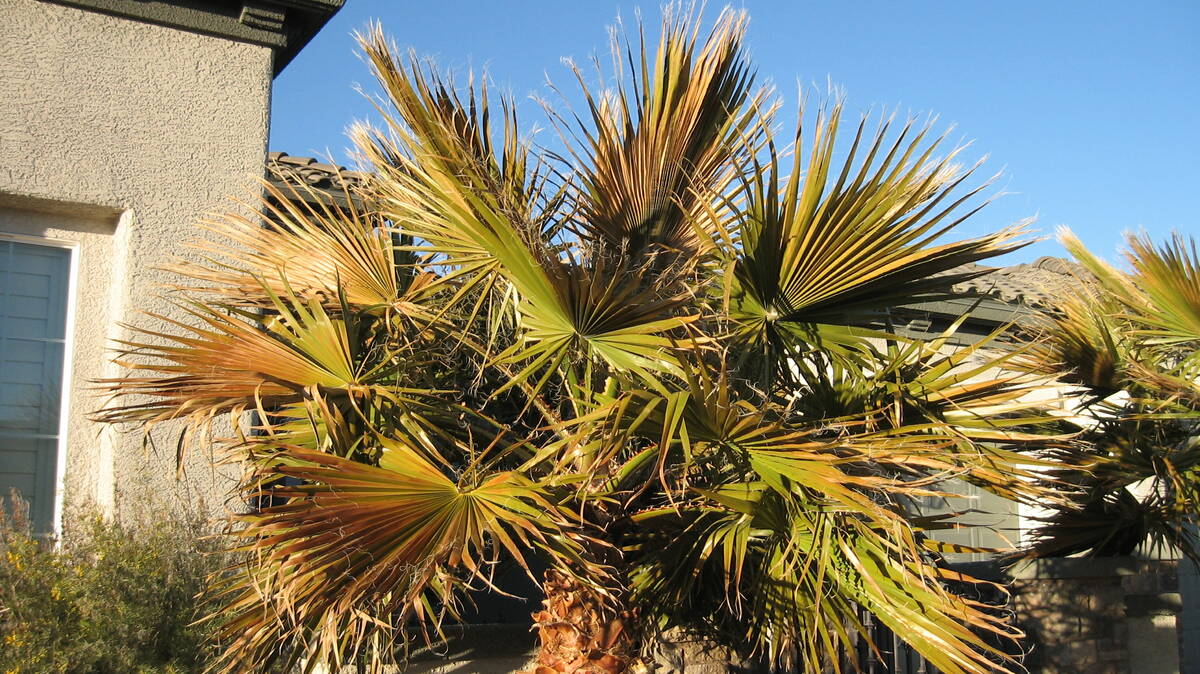Winter freezing temperatures can damage plants
This is the time of year, the second week of December, we normally experience the start of freezing temperatures. The likelihood of freezing temperatures increases through the winter.
Sometimes freezing temperatures occur in November, as they did a few years ago, but that’s rare and not normal. What I mean by freezing temperatures is plant damage that occurs anytime the air temperature drops below 32 degrees Fahrenheit.
As a reference point, the temperature inside most refrigerators is set to around 40 degrees F, or 8 to 10 degrees above freezing; too cold for most tropical fruit and plants but not too cold for temperate fruit and plants like apples and peaches. Chilling injury (plant damage that occurs because air temperatures are too cold for the plant but not yet freezing) is one reason many ripe tropical fruits, like tomatoes and bananas, should not be exposed to the 40-degree F temperatures of a refrigerator.
All parts of tropical plants such as tomatoes and bougainvillea experience chilling injury when temperatures drop a few degrees above freezing and may extend to 50+ degrees F. Chilling injury (as opposed to freeze or frost damage) occurs at different temperatures and depends on the plant.
Chilling injury damage to tropical and subtropical plants includes small stem and leaf discoloration, leaf roll, poor growth and susceptibility to some diseases like root or collar rot. Symptoms of chilling injury include a change in color such as yellowing or bronzing of leaves that ultimately results in leaf scorch or drop, the slowing or halting of growth, water-soaked patches in soft and semi-hard tissues, susceptibility to diseases, and wilting.
Chilling injury is due to cooler or cold weather (above freezing) temperatures to tropical plants growing outside of — or close to — the fringes of their normal range. As a side note, I noticed leaf and stem discoloration (closer in color to leaf bronzing) in mesquite, palms, citrus and a wide range of plants growing at different temperature ranges.
Vegetables can exhibit chilling injury and freezing damage as well. So-called warm-season vegetables such as tomatoes, peppers and eggplant can show chilling injury anytime the air temperature drops into the damaging temperature range I mentioned earlier. Cool-season vegetables, on the other hand, may sail through the same temperatures or lower, or require a crop cover when temperatures are below freezing.
Vegetable varieties may differ in their chilling injury by a few degrees. The Dragon’s Tongue variety of bush bean is more susceptible to collar rot (chilling injury) when grown in garden soil a few degrees cooler than other bush bean varieties.
Temperate fruit like apples and pomegranates, unlike tropical fruit like tomatoes and bananas, are not damaged at refrigerator temperatures (around 40 degrees) because fruit from these trees can handle these lower temperatures. The ideal storage temperature for these types of fruit is somewhere close to freezing and combined with high humidity. High humidity slows water loss and helps delay some fruit from shriveling.
The freezer part of our refrigerator is set to around 32 degrees F, or about 10 degrees below the refrigerator temperature. Our nighttime winter temperature frequently drops to a “refrigerator temperature” range at night during the late fall, winter and early spring and occasionally into the “freezer temperature” range during the early morning hours of December, January and occasionally early February. When nighttime temperatures reach the “freezer range” is when we often times see plant damage or experience fruit loss, but we may not know it yet.
Open flowers of any fruit (citrus, peach, apple and others) can’t handle temperatures below freezing even though most plants or trees might show no damage at all. When flowers are simply buds and not yet open, there is a small amount of freeze protection provided to the developing flower. This freeze protection starts disappearing as the flower buds mature into open flowers.
As the flower begins opening, and the frost-sensitive ovary is surrounded by the freezing night air, is when we experience damage or fruit loss. Fruit loss due to a frozen flower ovary can happen in a few seconds.
This is why sprinklers, ultimately resulting in applied water turning to ice on the flowers, are used in orchards to prevent freeze damage to flowers (ovary). The act of water freezing releases a small amount of heat that protects flower ovaries from death.
If you are curious if the ovary of a flower from your fruit tree was damaged during a freeze, pull the flower apart a few days after a suspected freeze and inspect the ovary for death. Ovaries that eventually turn into fruit will be robust and green. Dead flowers drop from the tree early or have a dull, water-soaked appearance if they are still attached.
Just because the flower you inspected was dead doesn’t mean there will be no fruit produced at all. It takes about two or three weeks for all the flowers to open in spring flowering plants. Several consecutive light freezes in a row (or only one hard freeze) are needed to totally wipe out a crop of fruit from a mature tree.
There is a temperature difference between the freezing death of open flowers and the freezing damage or death of a plant or tree. For citrus, this difference can range from the same temperature as flower death (32 degrees F for limes and true lemons) to lower temperatures (mid-20 degrees F for Meyer lemon, grapefruit and kumquat). Much of this depends on how many minutes or hours a killing freeze lasts and at what temperature.
The temperature and duration of that temperature are what is critical. With open flowers, freezing temperatures are needed for just a minute. With plant or tree death, the same temperature is needed for a longer time period.
With some fruit trees (such as citrus), the temperature difference between flower and tree death can be small (0 to 7 degrees). In other fruit trees (such as apples, pear, peach and apricot), it can be much greater (20 degrees or more).
What to do about freezing temperatures and fruit or plant loss? Track and use weather station apps during times when freezing temperatures might occur. Buy a recording thermometer for your backyard and hang it in your important trees. If you are into growing vegetables, use a soil thermometer to judge when to precisely plant.
Move fruit trees to a new location. If your fruit trees are less than 3 to 4 years old, now is the time of year to move them. South- and west-facing sides of walls and buildings are tough to grow plants because of the heat they reflect.
Some citrus is in landscape wind tunnels that remove flowers during strong winds. North and east sides of buildings and walls as well as backyards have a gentler environment.
In cooler, gentler areas of the landscape expect flowering to be two to three weeks later. Group plants together so they can share water and fertilizer, and protect each other. If they can’t be grown together, consider constructing wind barriers.
Try kumquats which are cold hardy, subtropical citrus trees. The small fruit can be freshly harvested and eaten from the tree but still gives you that citrus kick.
Kumquats flower several times during the summer instead of just once and yet are small enough to grow in a container. Flowering more than once during a single growing season increases your chances of having a successful crop if you have late or multiple freezes.
Grow fruit trees that flower continuously. Pomegranate, fig and jujube are temperate cold- and heat-tolerant fruit trees that flower continuously through the growing season.
Always group plants and fruit trees together. Improve the soil at the time of planting and every couple of years. The water, soil improvement and shade that they provide and share are a big benefit to them when grown in the desert.
Bob Morris is a horticulture expert and professor emeritus of the University of Nevada, Las Vegas. Visit his blog at xtremehorticulture.blogspot.com. Send questions to Extremehort@aol.com.





























